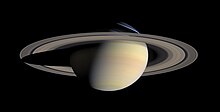Lubat-saguš
Lubat-saguš or Uduimin-saĝuš (also Lubat -sagusch, Uduimin-sagusch; Sumerian LU.BAT SAG.UŠ, MUL UDU.IMIN-saĝ-uš, " star of the sun ") and Kajamanu ( Akkadian ka-ja-ma- nu for "the constant") is the Mesopotamian name of the planet Saturn in ancient times .
In the Sumerian naming, the brightness in the night sky played the decisive role, since Saturn was also called the “sun of the night” in addition to the “star of the sun” and was considered to be the “star of Ninurta ”. The god Ninurta was responsible for the fertility of the herds and fields. In addition, he also had warlike aspects and was able to recapture the stolen tablets of fate from the petrel Anzu .
In the context of the “star of the sun”, Saturn is compared in omina texts with the position of the sun in the court of the moon , which is why Saturn represented the sun as its official representative. Eratosthenes later attested to the well-known name "Sun of the Night". In Babylonian mythology , the name kajamanu refers to the slow orbital speed of Saturn.
See also
literature
- Franz-Xaver Kugler : Astronomy and star service in Babel - Assyriological, astronomical and astral mythological investigations -; Book 1: Development of Babylonian Planetary Science - From Its Beginnings to Christ - . Aschendorff, Münster in Westphalia 1907, p. 8.
- Manfred Lurker : Lexicon of gods and demons. Names, functions, symbols / attributes (= Kröner's pocket edition . Volume 463). 2nd, expanded edition. Kröner, Stuttgart 1989, ISBN 3-520-46302-4 , p. 297.
- Ulla Koch-Westenholz : Mesopotamian astrology - An introduction to Babylonian and Assyrian celestial divination - . Carsten Niebuhr Institute of Near Eastern Studies, Copenhagen 1995, ISBN 87-7289-287-0 , pp. 122-123.
